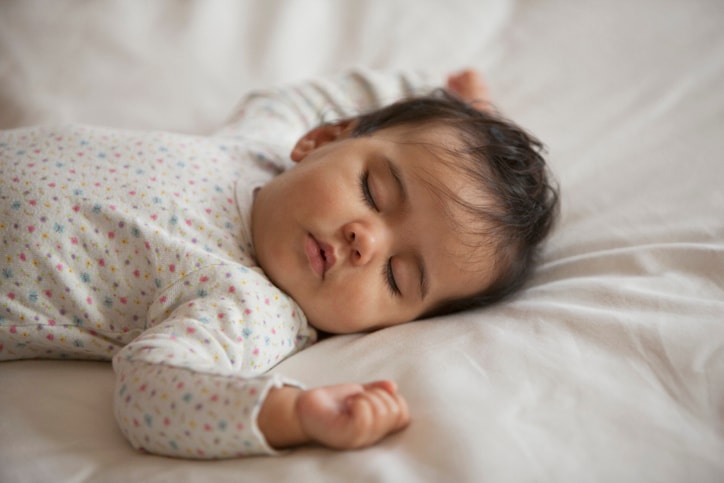Do babies dream? Like “when do babies start laughing?” it’s a common question with a complicated answer. Even the youngest babies can be very active in their sleep, making some funny (and adorable) noises or faces. When you see a slumbering baby twitch, smile or gurn, you might imagine they’re drifting through a dreamworld, perhaps surrounded by teddies or playing with the family dog.
The fact is, there’s a lot that even scientists don’t know about the infant brain. Here, we look at what is known by human development and neuroscience experts about the sleep cycle for newborns and what goes on in babies’ brains while they’re snoozing.
Do babies dream when they’re asleep?
The short answer is: no one really knows for sure. That’s because the only way we really know that anyone dreams is because they tell us. So, until a child is old enough to explain that they had “the weirdest dream”, we can only wonder.
The general consensus has long been that babies don’t have dreams — or, at least, vivid ones — until the age of around two. That’s because their brains aren’t sufficiently developed for this purpose. But some recent studies of whether babies have consciousness have found that the infant’s developing brain is likely capable of conscious experiences — perhaps even from birth.
What we do know for sure is that babies’ slumbering brains are very busy. Research has shown that, while they’re sleeping, they consolidate memories of things they’ve experienced while awake and may even be processing stimuli in their environment. That’s why newborns’ sleep is so crucial for their development.
What’s more, an infant’s brain works differently than an adult’s or older child’s, even during the daytime. While they can store memories, they don’t develop “episodic” memories — or recollections of specific events — until the age of 3 or 4. A newborn baby has not learned or experienced much yet, so even if they do dream, it’s probably not in the same form as older children or adults.
How does the sleep cycle for newborns differ from that of adults?
As any new parent knows, newborns can nod off in the middle of the day but be ready to party in the middle of the night. That’s because they aren’t born with circadian rhythm — the natural internal cycles that signal to our body when it’s time to sleep. These start to develop at around 2 to 3 months old and, according to baby sleep consultant Emma Gawne, parents can support the development of their baby’s circadian rhythm by helping them distinguish between day and night.
When adults fall asleep, we go through two sleep phases: non-rapid eye movement (NREM) sleep, and rapid eye movement (REM) sleep, which is associated with vivid dreaming. A full sleep cycle involves going through all of these states, and a typical night might consist of four to six sleep cycles, each lasting an average of 90 minutes.
Newborns, on the other hand, are like cats and can snooze for up to 18 hours in a 24-hour period — alas (for new parents!) not all in one go but broken down into short bursts of time. According to the existing research, a given sleep session for a newborn consists of only one or two sleep cycles. During these cycles, they may go through several phases:
- active sleep;
- quiet sleep;
- indeterminate sleep.
How can you tell which sleep phase a baby is in? Well, if the infant is twitching in their sleep and their breathing is irregular, they are in active sleep. When they become still, that’s quiet sleep. If newborn movement during sleep is somewhere in between, this is indeterminate sleep.
When do babies start dreaming?
Again, the jury of experts is still out regarding the exact age at which we begin to dream. Most believe it to be around the age of 2, though. Certainly, it’s shortly after this age that children generally start to describe their dreams. Often, they begin by disclosing bad dreams. According to the NHS, night terrors are most common in children between the ages of 3 and 8, while nightmares can affect both children and adults. It is generally believed that babies and young ones under the age of 2 are not capable of having nightmares, however, as their imaginations are not sufficiently developed.
What does infant movement during sleep mean if they’re not dreaming?
Babies can be highly active in their sleep — all flailing arms, twitches and jerky movements. If it’s not dreams that are causing this, then what is? This is another question that has fascinated experts, who generally attribute it to REM sleep. Infants have more of this than adults, and this cycle of sleep is characterised by twitches of the limbs, eyes, face, etc.
Neuroscientists believe that, in babies, REM sleep allows their brain to develop pathways and connections, which are important for learning and memory. Another school of thought is that twitches, which are produced in the brain stem, can activate specific parts of the brain that external stimulation cannot. This, in turn, helps build precise and functionally complete brain circuits.
The bottom line on sleep cycles for newborns
Whether or not babies dream, their brains are doing lots of hard work while they’re napping. Kids of all ages need a lot more sleep than the typical adult. Most infants don’t sleep through the night until they’re at least 4–6 months old, and many continue to wake at night well beyond that age. So, while we may be left to wonder what’s actually going on in their minds, there’s no question that whatever it is, it’s helping them grow and thrive.
